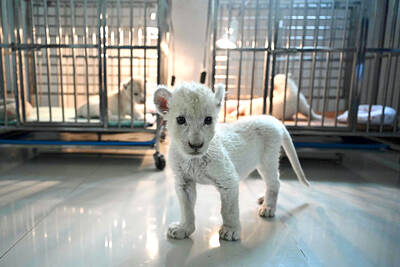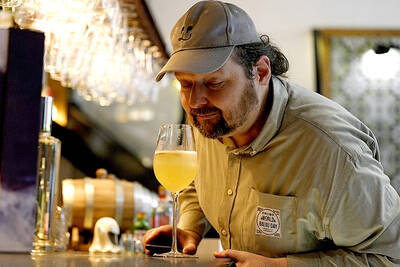A shaman blows a bull’s horn on festival day and pivots to clouds of burning incense in a purification ceremony, all shot on video.
The snapshot of native American life opens Nukanchik Yuyay, a twice-daily newscast in Quechua, the language spoken by millions of people across the Andes and enjoying a revival as even presidents take up its cause.
The program’s newscasters speak below a woolen tapestry of Cotopaxi, a glacier-capped volcano within sight of the station, Ecuador’s channel 47. Besides the station’s cameras, a wolf mask bares white fangs.
Based in Latacunga, 80km south of Quito, Channel 47 says it is the world’s first television station for Quechua speakers. On air since July, it features 30 percent Quechua programs and aims to go mostly monolingual as its audience increases.
“Our next project is Quechua cartoons ... to draw in children,” says station manager Angel Tiban.
Channel 47’s appearance is a part of broader efforts to inject new life into Quechua, repressed by late Spanish colonial powers. New constitutions in Bolivia and Ecuador, enacted under leftist presidents, enshrine Quechua as an official language, and Bolivia this year founded the first Quechua-speaking university.
In Ecuador, Rafael Correa is the nation’s first fluent Quechua-speaking president in memory.
Quechua speakers live along the Andes, from Argentina and Chile in the south to Colombia in the north, where it’s called ingano. Most are in Peru, Bolivia and Ecuador.
First spread by the Incas, Quechua expanded its reach under the Spanish who used it to spread Roman Catholicism.
For centuries, university professors taught the language at the region’s premier university, San Marcos. Quechua books and theater on Inca history flourished. But that suddenly halted and classes were banned after colonial authorities crushed an Indian rebellion in 1781 led by Jose Gabriel Condorcanqui, who adopted the name of Inca ruler Tupac Amaru.
Estimates of Quechua speakers range from 6 million to 13 million, but linguists say that even now some Andeans still won’t tell census takers they speak the language because of its long association with backwardness and low social status.
CHANGING STATUS
“Kichwa (Quechua) used to have no prestige ... If you wanted prestige, you learned English, French or German,” says linguist Jose Maldonado, a presidential adviser who provides a weekly recap in Quechua on national television of Correa’s activities.
Now, Ecuadoreans outnumber Americans in Quechua classes at Maldonado’s university and bodyguards, police and civil servants at the presidential palace are signing up for in-house classes.
With an eye on younger generations, Quechua educators and broadcasters are also seeking to promote the “cosmovision” of Indian peoples once ruled by the Incas. It invokes the intricate balance of dualities that make up the world.
“In geography, we want to teach that there are male mountains and female mountains, and sometimes a smaller mountain between is a child,” said Alberto Conejo, academic director of intercultural bilingual education at Ecuador’s education ministry. He wore a blue poncho and many bureaucrats on the high-rise floor wore traditional Indian dress.
To illustrate “cosmovision” to a recent vistor, Channel 47 manager Tiban rolled tape of a native flutist’s Quechua interview, and interpreted: “He is saying some wind pipes are masculine, others are feminine, and that they have to be in equilibrium for harmony.”
Quechua “cosmovision” dualities include hot and cold, and night and day, said Lucila Lema, a bilingual poet who until this month hosted the Quito-based Quechua newscast Kichwapi or In Quechua. It is the first national newscast of the day on an otherwise Spanish-language network RTS.
Kichwapi colleague Enrique Conejo said some terms defy easy Quechua translation: “The word inflation is a headache.” But other translations have gained traction. Kichwapi now calls a car antawa — derived from the Quechua word anta, or metal.
Quechua promoters are campaigning to turn national legislatures into bilingual bodies but the Ecuadorean bid has already met resistance, says congressman Pedro de la Cruz.
Congressional authorities told him it cost too much to pay for simultaneous interpreters and translation cabins.
As a compromise, he said, the National Assembly allows a quartet of Indian legislators to speak five minutes in Quechua on top of lawmakers’ standard 10-minute Spanish time cap.
The Web sites of Ecuador’s National Assembly and Peru’s Congress now feature extensive Quechua sections.

Behind a car repair business on a nondescript Thai street are the cherished pets of a rising TikTok animal influencer: two lions and a 200-kilogram lion-tiger hybrid called “Big George.” Lion ownership is legal in Thailand, and Tharnuwarht Plengkemratch is an enthusiastic advocate, posting updates on his feline companions to nearly three million followers. “They’re playful and affectionate, just like dogs or cats,” he said from inside their cage complex at his home in the northern city of Chiang Mai. Thailand’s captive lion population has exploded in recent years, with nearly 500 registered in zoos, breeding farms, petting cafes and homes. Experts warn the

No one saw it coming. Everyone — including the Chinese Nationalist Party (KMT) — expected at least some of the recall campaigns against 24 of its lawmakers and Hsinchu Mayor Ann Kao (高虹安) to succeed. Underground gamblers reportedly expected between five and eight lawmakers to lose their jobs. All of this analysis made sense, but contained a fatal flaw. The record of the recall campaigns, the collapse of the KMT-led recalls, and polling data all pointed to enthusiastic high turnout in support of the recall campaigns, and that those against the recalls were unenthusiastic and far less likely to vote. That

The unexpected collapse of the recall campaigns is being viewed through many lenses, most of them skewed and self-absorbed. The international media unsurprisingly focuses on what they perceive as the message that Taiwanese voters were sending in the failure of the mass recall, especially to China, the US and to friendly Western nations. This made some sense prior to early last month. One of the main arguments used by recall campaigners for recalling Chinese Nationalist Party (KMT) lawmakers was that they were too pro-China, and by extension not to be trusted with defending the nation. Also by extension, that argument could be

The centuries-old fiery Chinese spirit baijiu (白酒), long associated with business dinners, is being reshaped to appeal to younger generations as its makers adapt to changing times. Mostly distilled from sorghum, the clear but pungent liquor contains as much as 60 percent alcohol. It’s the usual choice for toasts of gan bei (乾杯), the Chinese expression for bottoms up, and raucous drinking games. “If you like to drink spirits and you’ve never had baijiu, it’s kind of like eating noodles but you’ve never had spaghetti,” said Jim Boyce, a Canadian writer and wine expert who founded World Baijiu Day a decade